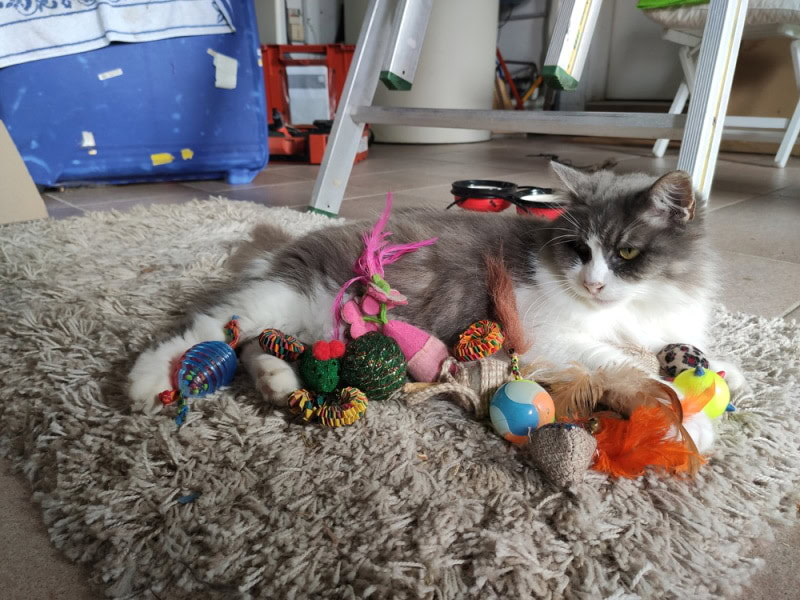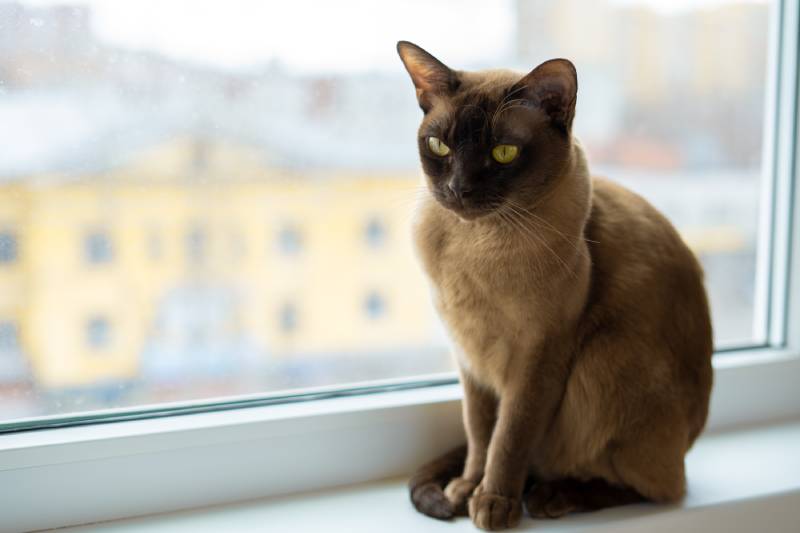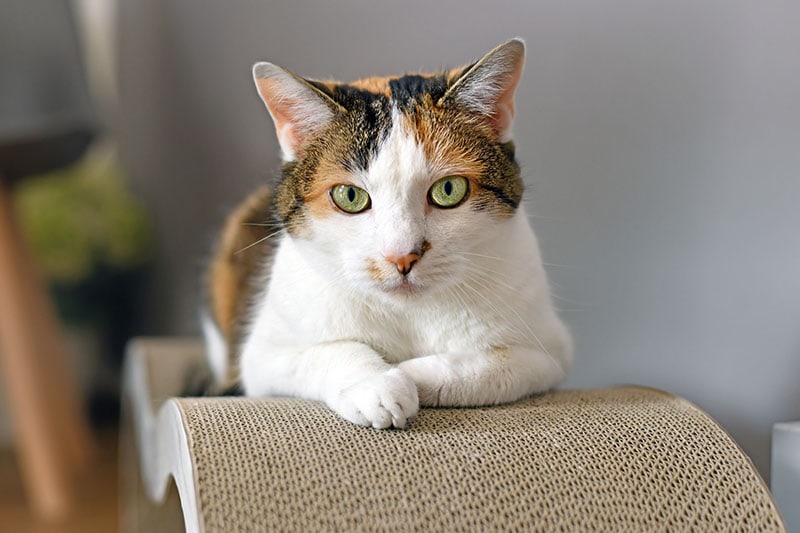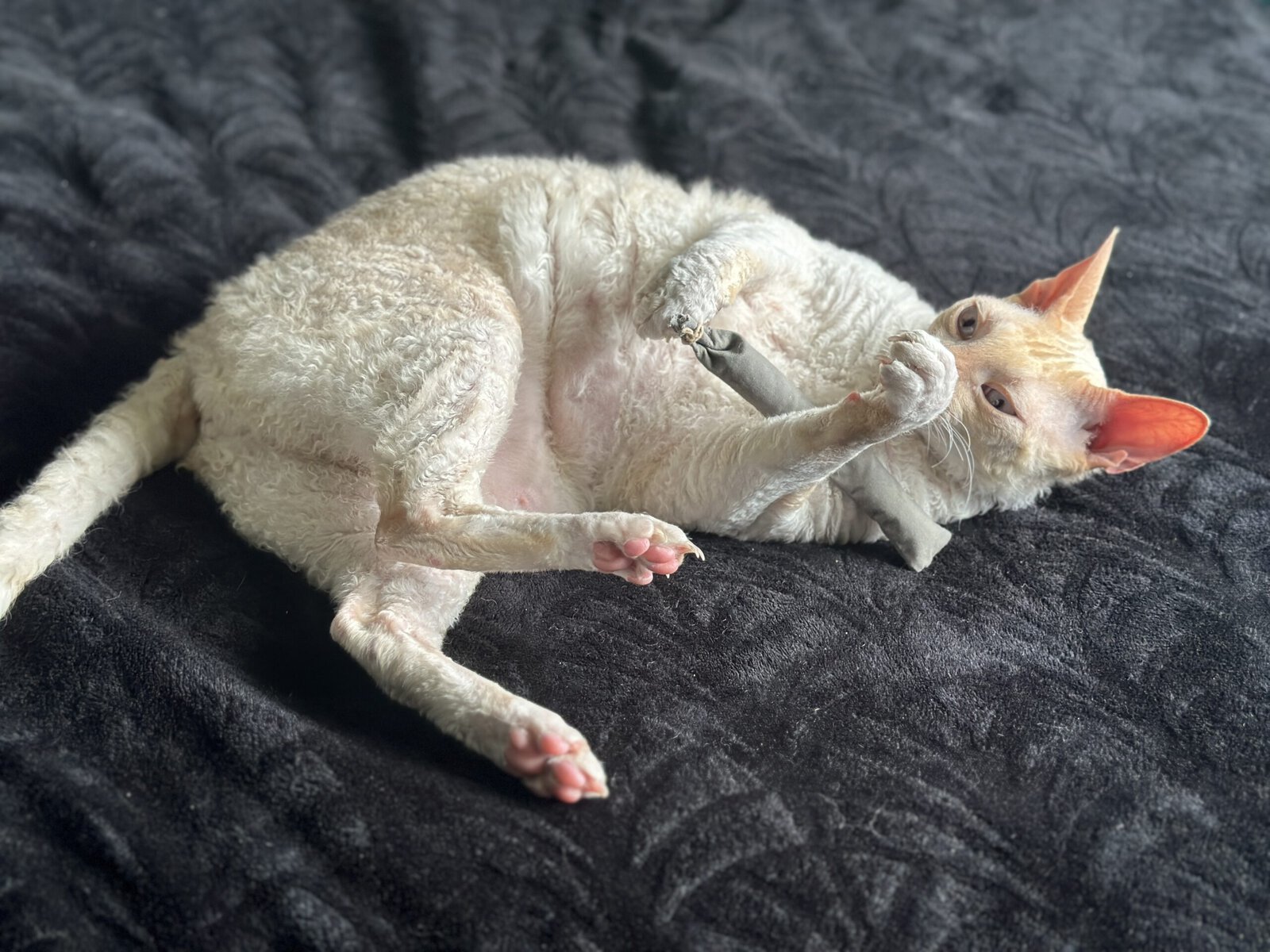Click to Skip Ahead
Cats are instinctive predators, and suitable cat toys can help them stay physically active and mentally sharp. Any toy your furball can stare at from a distance, stalk, and pounce on can give it hours of enjoyment and entertainment.
Have you just adopted a furry friend and want to strengthen the bond between you? Read on to learn about six types of cat toys that can turn your dull pet into a playful furball.
We’ll also discuss how to use these toys to keep your feline engaged. Our detailed breakdown will additionally provide tips for using cat toys during training sessions or managing behavioral problems.

The 6 Types of Cat Toys
1. Catnip Toys
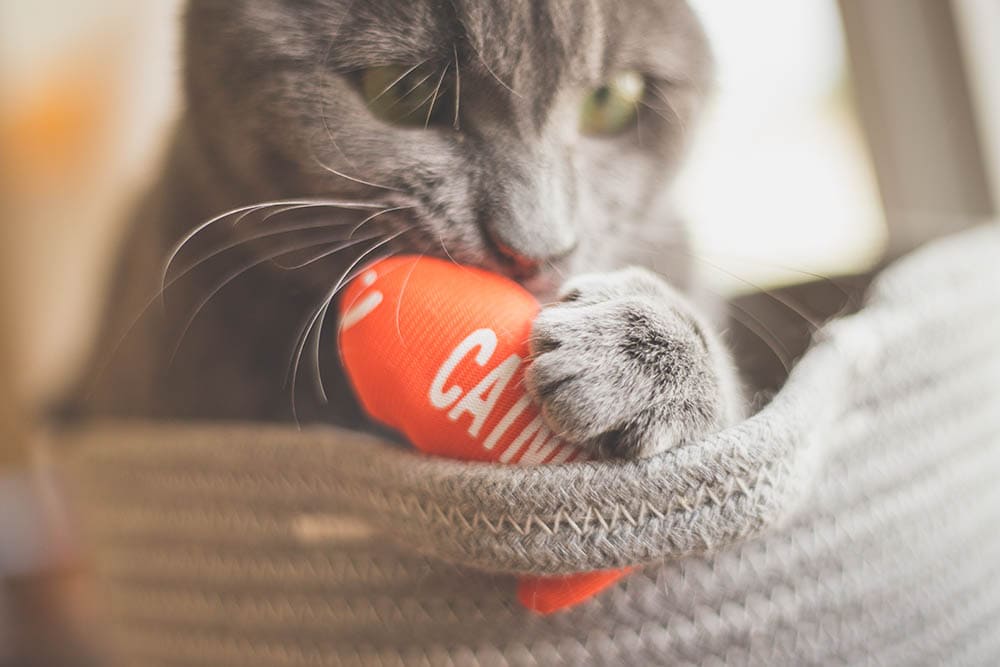
If your cat gets bored of toys quickly or turns its head the other way each time you purchase a new toy, it’s time to try catnip toys. Most cats find catnip irresistible and will not just attack catnip toys but also toss them around, chew, and roll over with them. You could use these toys to take your play sessions a notch higher.
Playing with catnip toys for just a few minutes will ensure your furball enjoys a euphoric high for 5 to 15 minutes. After this, it will mellow out and possibly take a nap.
Catnip toys, as the name suggests, contain catnip. This euphoria-inducing herb has the active ingredient nepetalactone. This is a powerful psychosexual stimulant that can turn even the laziest cat into a ball of energy and excitement.
Catnip is safe for cats, whether sniffed or ingested.
However, not all cats are sensitive to it, and this depends on their genetics, but about 60-80% of cats will be attracted to and respond to catnip.
Catnip can really enrich your cat's life, especially if you choose a fun, well-built catnip toy. Our favorite option is Hepper's Catnip Stick Toy, which offers sturdy construction, 100% organic catnip fill, and a great range of colors. These toys are handmade in the USA and feature bite-proof double bagging.
- No Filler - Like all the best cat toys our is stuffed with 100% organic catnip. Cheap cat toys with...
- Flexible Play - Simple plush shape is great for biting, scratching and pawing. It can start life as...
- Durably Designed - Our cat safe toys are hand-stitched with a double-lined exterior construction for...
At PangoVet, we've admired Hepper for many years, and decided to take a controlling ownership interest so that we could benefit from the outstanding designs of this cool cat company!
2. Wand Toys
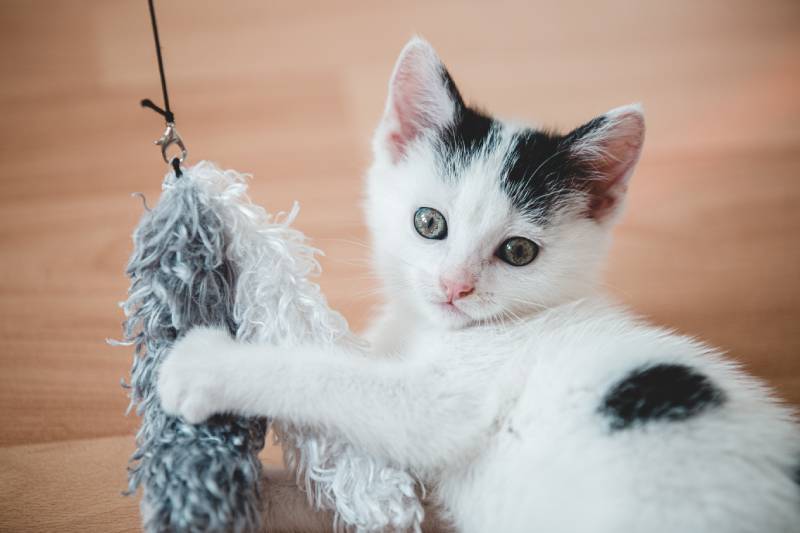
Wand toys or cat teasers are interactive toys that enchant cats. They consist of a pole, a string, and an attachment toy at the end. These toys spark a cat’s instinct to hunt, as the attached toy serves as its prey.
Wand toys, apart from the all-in-one options, come with several attachments. Some brands offer as many as five to seven attachments, allowing you to change your feline’s prey choices. If your cat loves hunting birds, a wand toy with a feathered attachment will do the trick!
Cats love scheduled playtime, and some consistency in your routines will make your furball happy. If you want to use wand toys for the first time, begin with short two-minute sessions before working your way up to 5, 10, or 15 minutes of play. Depending on your cat’s preferences and energy levels, however, in general, they have a short attention span, so you could opt for several short play sessions daily.
Wand toys are attractive to cats because they mimic live prey. They are interactive toys, and you will need to stick around to move the wand around and let your furball stalk and attack the “prey.” Experiment with different movements and speeds. Interchange quick movements with slow crawls to see how your cat reacts.
3. Scratchers
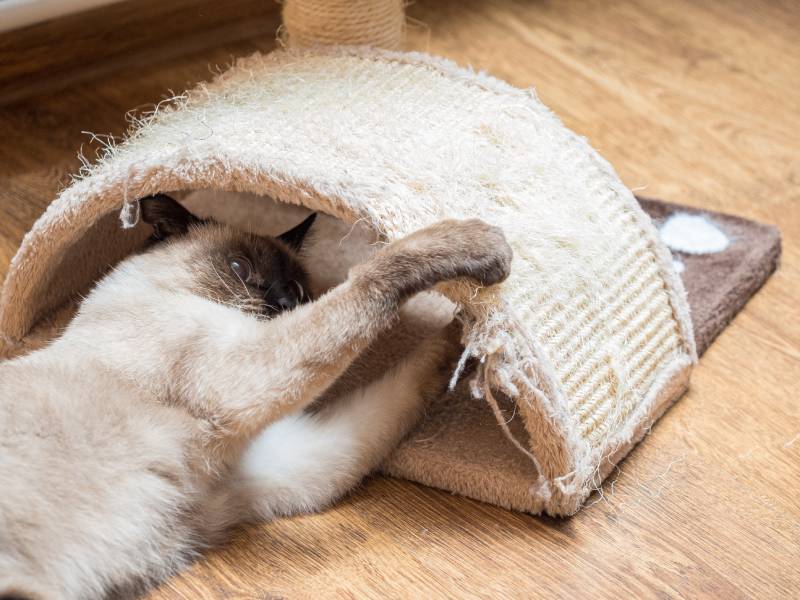
Cats have a natural tendency to scratch. They can scratch your furniture, carpet, or drapery to sharpen their claws, relieve stress, and mark their territories. Also, they can scratch to give their backs a good stretch.
Unfortunately, you cannot train your cat not to scratch. Your best bet is to direct the scratching to an acceptable area. A scratching toy is just what you need to ensure your furry friend can scratch to its heart’s content.
Scratchers come in different shapes, materials, and sizes. The most common ones are made from cardboard, wood, sisal, or carpet. Proper positioning of the scratcher will ensure your cat uses it instead of your couch. You can place it near the cat bed, litter tray, or sofa that your pet loves scratching.
If your furry friend still resists using its scratcher, you can motivate it by first ensuring the post is made of your cat’s preferred material. Also, consider rubbing some catnip powder or other pheromone product on the scratcher’s surface. If this does not work, consider buying multiple scratchers and placing them in different locations.
We're big fans of using cardboard as a material for cat scratchers, which is why it's no surprise that our favorite scratcher, the Hepper Hi-Lo Cat Scratcher, is made with cardboard. With a durable, sturdy, and modern-looking birch plywood frame, this scratcher is designed to make both cats and their hoomans happy. You can set it up in three different ways, too, to keep your cat fit and entertained. Click here to learn more.
At PangoVet, we've admired Hepper for many years, and decided to take a controlling ownership interest so that we could benefit from the outstanding designs of this cool cat company!
4. Cat Trees / Climbers
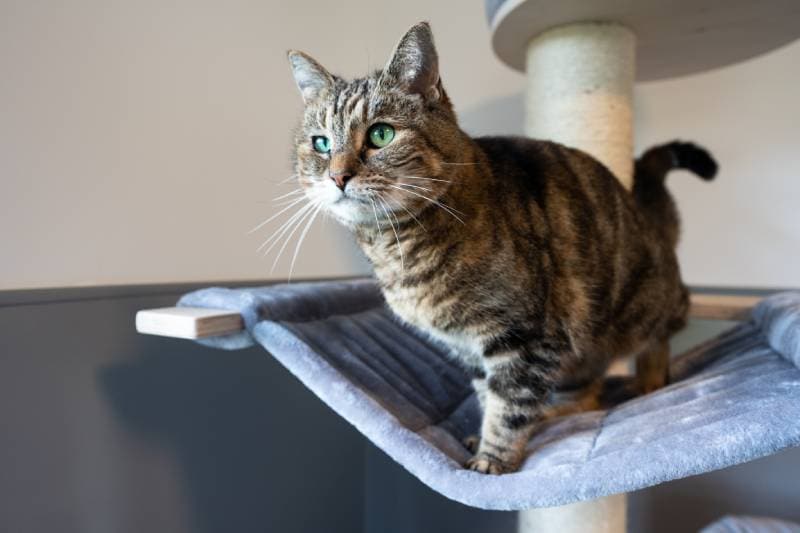
Cat trees, also known as cat climbers or climbing towers, target felines’ predatory and defensive instincts. Cats love climbing because a high position gives them an aerial advantage over their “prey.” Also, they love scratching to keep their claws sharp and ready to attack.
A cat tree can allow your furball to indulge in its hard-wired tendency to climb and scratch. Some structures feature hiding spots where your cat will also have a blast exploring.
Climbing towers have a sturdy base and extended arms with tunnels and hiding spots. Some also feature scratching poles to make them more attractive to felines. If your furry friend ignores the tower, you can entice them to explore it by sprinkling some catnip or placing their favorite toy inside.
A cat tree can be an invaluable toy if you want to redirect your cat’s undesired behaviors. For instance, it can help prevent your furry friend from climbing to unsafe spots or scratching your furniture.
5. Laser Toys
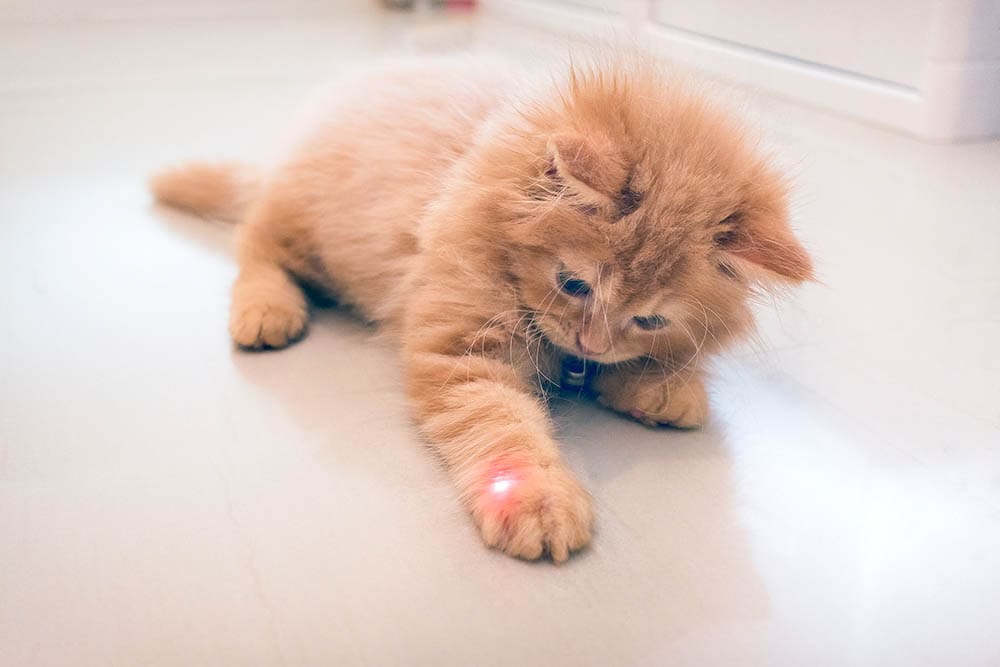
Laser toys are perfect for mental stimulation. The laser beam mimics fast-moving prey and will intensely engage your furry buddy as the tiny bright light bounces off the floor, walls, and the feline’s body.
The markets have parades of laser toys, and while some are for interactive play, you can find automatic laser toys ideal for solo play. However, studies have found that laser toys can cause frustration and behavioral problems to cats as they never allow them to catch the prey and have a win. So, if you wish to provide your cat with a laser toy, we recommend sticking to the manual ones you can control because it is important to have a toy and a treat handy to let them catch and eat their prey.
The ideal way to use a laser toy is to ensure your cat does not leave empty-pawed. Cats love the satisfaction of hunting their prey and catching it. If your furry friend cannot win, playing with a laser toy will likely cause frustration after a fun session of mind-blowing play.
Before you wrap up your play sessions, introduce a toy in the game. A stuffed catnip toy would be ideal because it will redirect your cat’s attention. Also, your furry friend can feel more content after actually “killing” the prey.
- Related Read: Why do Cats Love Lasers? 3 Reasons Why
6. Puzzle Toys
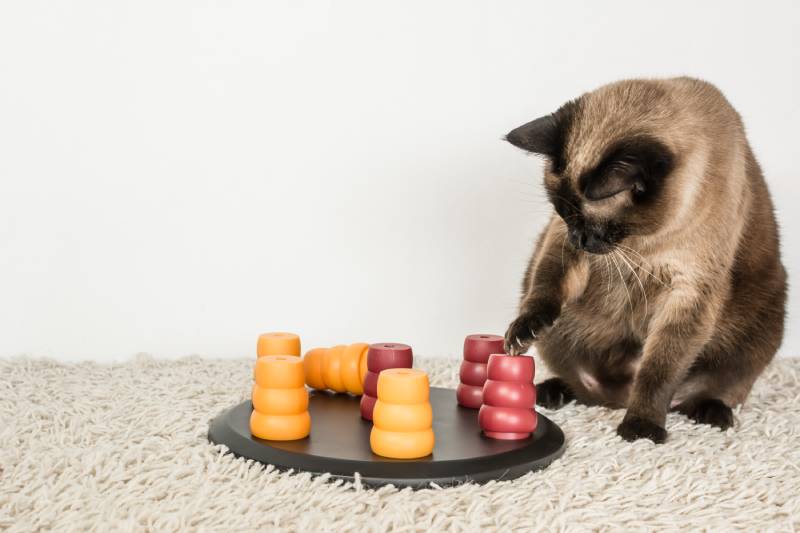
Cats are curious and love piecing up puzzles to figure out where you hide their food, how to sneak outdoors, and even how to get into the cat food cabinet. Moreover, it is common for cats to come up with unique games, including those that encourage undesirable behavior.
Puzzle toys provide mental stimulation by targeting your cat’s curiosity and hunting instincts. You can hide treats or catnip toys inside a puzzle and give your furry friend a few minutes to find a way to obtain their favorite goodies.
Cats enjoy their puzzles better when they are not too hard or impossible to solve. Because they also have a strong sense of smell, you can use scents to make it easier for them to discover hidden stuff within the puzzle.
For instance, you can hide treats in different compartments to slow your cat down when eating. It has to sniff out where you are hiding its catnip toy and possibly work its way through a small opening to get to its catch.

Tips for Using Cat Toys
- Figure out your cat’s preferences
- Prioritize safety, especially if your cat’s play sessions are unsupervised
- Use catnip or silvervine powder to encourage your furball to play with its toys
- Use a different toy during each play session to keep games exciting
- Spare at least 15 minutes daily to engage in interactive play with your cat
- Let your furry buddy win at the end of the play session
- Be creative and find different ways to engage your cat with the available toys

FAQ
Cats are clever, curious, and playful. Cat toys can stimulate your furry friend physically and mentally by providing the opportunity for it to hunt, run, and jump. Here are a few frequently asked questions about cat toys.
Is It Worth It to Invest in Cat Toys for My Furry Friend?
Cat toys provide mental stimulation and encourage felines to exercise and avoid gaining unhealthy weight. Moreover, toys provide a healthy and safe outlet for natural hunting and scratching instincts and can help address various behavioral problems. Investing in cat toys is worth it because playtime can reduce the risk of common feline illnesses like diabetes and obesity.
Which Are the Best Cat Toys?
In general, cat toys help to keep felines happy and healthy. The best toy for your furry friend will depend on its preferences and your goals. Different toys offer unique benefits, and investing in at least three types of toys is always ideal. For instance, a catnip toy can make a lazy couch potato more playful. On the other hand, interactive toys like wand toys can foster the bond between you and your pet. Providing variability will ensure that toys remain interesting for your cat while enriching their lives.
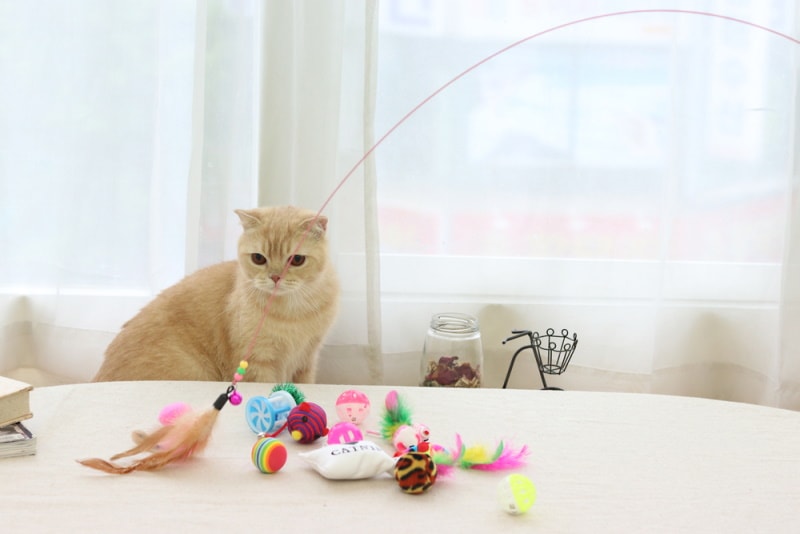
Which Are the Best Solo-Play Cat Toys?
Cats dislike staying at home alone with nothing to do. Often, they get into mischievous behaviors in a desperate attempt to kill boredom. If you are not around to interact with your pet, you should consider using puzzle toys, interactive toys, remote treat-dispense cameras, or scratchers. The best choice will also depend on your cat’s preferences.
How Often Should I Play With My Cat?
Cats have different needs and personalities, and it is perfectly okay to schedule play sessions based on your best judgment. Also, pet parents have varying schedules that may limit the amount of time they can engage their pets in interactive play. Generally, you should play with your cat for 5 to 30 minutes daily. Don’t make the sessions too short, and also avoid overstimulating your furball.
Why Does My Cat Not Like Its Toys?
Mastering your feline’s play style and preferences can be a bit of a learning curve. Identifying the cat toys your pet fancies may take trial and error. While some cats prefer toys that mimic prey movements or textures, others react better to toys that squeak, twitter, or crackle when squeezed. Also, some cats are adventurous and prefer hiding games over hunting games.

Summary
Generally, most felines love toys that allow them to mimic predatory acts. Hunting is an instinct, and your furry buddy will enjoy invaluable entertainment as it explores a new plaything and then stalks, chases, pounces, captures, bites, carries, or rolls around with its “prey.”
In between play sessions, your cat may retreat with its head down and watch its toy from a distance. This may imply that the game is at its climax. Your furry friend is simply resetting and creating a new strategy to attack!
Featured Image Credit: Darlow82, Shutterstock
